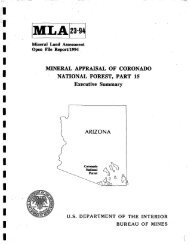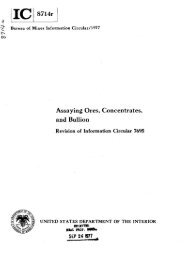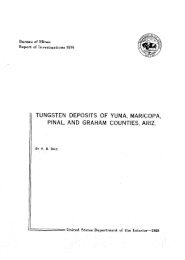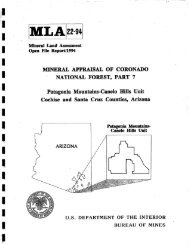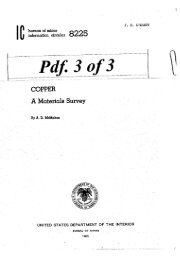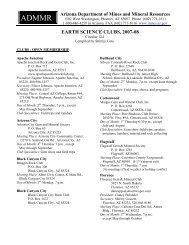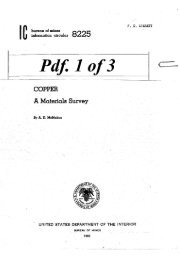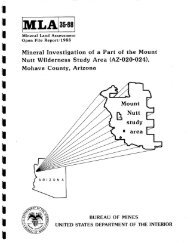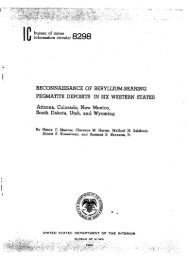USGS Professional Paper 1361 - State of Arizona Department of ...
USGS Professional Paper 1361 - State of Arizona Department of ...
USGS Professional Paper 1361 - State of Arizona Department of ...
You also want an ePaper? Increase the reach of your titles
YUMPU automatically turns print PDFs into web optimized ePapers that Google loves.
18 GEOLOGY AND GOLD MINERALIZATION OF THE GOLD BASIN·LOST BASIN MINING DISTRICTS, ARIZONA<strong>of</strong> the study area and 6.8 km south <strong>of</strong> 1'emple Baryields a K-Ar age <strong>of</strong> 10.9±0.6 Ma. This age is the same(11.3±0.3, 11.1±0.5, and 10.6± 1.1 Ma), within the analyticaluncertainty, as that <strong>of</strong> the Fortification BasaltMember <strong>of</strong> the Muddy Creek Formation as reported byAnderson and others (1972). These ages were subsequentlydiscarded and a new set <strong>of</strong>ages <strong>of</strong> 4.9,5.8, and 5.9 Mawere adopted for the age <strong>of</strong> the Fortification BasaltMember <strong>of</strong> the Muddy Creek Formation (Lucchitta, 1979).The locality south <strong>of</strong> Temple Bar is at least 30 km east<strong>of</strong> Fortification Hill and 45 and 50 km east·southeast <strong>of</strong>the collection sites <strong>of</strong> the other basalt samples, so thesesamples are probably not from the same lava flow. Theconcordant ages on basalts indicate that basaltic volcanismwas widespread and from a number <strong>of</strong> vents in theregion from 11 Ma to 5-6 Ma.All <strong>of</strong> the silicic and intermediate volcanic rocks in theGold Basin-Lost Basin area (those correlated with thePatsy Mine Volcanics or Mount Davis Volcanics) are infault contact with surrounding older rocks. This low-anglefault is apparently some type <strong>of</strong> regional slide surface andnot a thrust fault. Other areas in southern <strong>Arizona</strong>, southeasternCalifornia, western Utah, and eastern Nevada inwhich the terrane is characterized by large slide blocks<strong>of</strong>Tertiary rocks have almost universally been related tometamorphic core complexes. Gravity tectonics caused bydoming <strong>of</strong> the core complex is the driving force that causesmovement <strong>of</strong> these large slide blocks. In the Gold BasinLost Basin area, sliding postdates the rhyolite unit datedat 15.4±0.2 Ma. A second period <strong>of</strong> sliding is recordedby low-angle fault surfaces between Tertiary conglomerate<strong>of</strong> the Muddy Creek Formation that is dated about10.9 Ma and older rocks including Proterozoic gneiss andthe Late Cretaceous two-mica monzogranite (see fig. 2).This second period <strong>of</strong>sliding is probably not much youngerthan about 10.9 Ma because the Hualapai LimestoneMember <strong>of</strong> the Muddy Creek Formation, a thick carbonateunit in the region about 8 Ma (Blair, 1978), is somewhatyounger (Lucchitta, 1979), is largely undeformed, and isnot in low-angle fault contact with older rocks.PETROCHEMISTRY OF CRYSTALLINE ROCKS ANDTHEIR RELATION TO MINERALIZATIONMetamorphic rocks in the Gold Basin-Lost Basin miningdistricts have been derived from igneous and sedimentaryprotoliths that were regionally metamorphosed to as highas upper-amphibolite-facies (Miyashiro, 1973) assemblagesand complexly deformed syntectonically during the olderEarly Proterozoic Mazatzal orogeny (see Wilson, 1939,1962). This orogeny occurred 1,650 to 1,750 Ma (Silver,1967). The Mazatzal orogeny thus correlates temporallywith the upper half <strong>of</strong> the Hudsonian orogeny in the CanadianShield, with final metamorphism in the Front Range,Colorado, and with the pre-Belt basement, Montana(King, 1969). Early Proterozoic metamorphic rocks in<strong>Arizona</strong> broadly compose three tectonic belts, <strong>of</strong> whichthe northwesternmost one, in the general region <strong>of</strong> theGold Basin-Lost Basin mining districts, is mostly gneissderived largely from an epiclastie protolith (Anderson andGuilbert, 1979); it also includes schist in the Vishnu Complex<strong>of</strong> Brown and others (1979) derived from shale andgraywacke protoliths and some thick sequences <strong>of</strong>gneissand amphibolite derived from mafic and, very locally,ultramafic protoliths. Metamorphic rocks in the districtsalso include metaquartzite, thin lenses <strong>of</strong> marble, calcsilicategneiss, banded iron formation, and metachert. Theprotolith(s) <strong>of</strong> these metamorphic rocks is difficult to correlateconvincingly with specific well-studied sequences<strong>of</strong> Proterozoic rocks in central <strong>Arizona</strong> (see Donnelly andHahn, 1981, for descriptions <strong>of</strong> these sequences). TheEarly Proterozoic Bagdad Belt <strong>of</strong> Donnelly and Hahn(1981) includes relatively thick sequences <strong>of</strong> coarse- t<strong>of</strong>ine-grained metamorphosed wackes ncar the top <strong>of</strong> theoverall metamorphic pile there. Some <strong>of</strong> these metamorphosedwackes may be correlative with quartz<strong>of</strong>eldspathicgneiss at Gold Basin-Lost Basin.The gneiss exposed in the Gold Basin-Lost Basin miningdistricts contains highly deformed and lithologically complexsequences that commonly grade or change abruptlyinto one another across short distances. Although aquartz-plagioclase (oligoclase or andesine) or quartz<strong>of</strong>eldspathicgneiss is probably the predominant rock typeoverall <strong>of</strong> the gneiss unit, quartz<strong>of</strong>eldspathic gneiss is complexlyinterlayered with other lithologies in many outcrops(fig. M). In addition, moderately thick, layered sequences<strong>of</strong> predominantly quartz<strong>of</strong>e1dspathic gneiss may gradeinto sequences consisting mostly <strong>of</strong>amphibolite by subtleyet marked changes in the relative proportions <strong>of</strong>quartzo.feldspathic gneiss and amphibolite along strike. Some <strong>of</strong>the amphibolite in the districts will be shown, in the followingsection, to have an igneous protolith. In some sequenceswithin the gneiss unit, rather abrupt transitionsare also present across conformable contacts, perpendicularto lithologic layering between predominantlyquartz<strong>of</strong>e1dspathic gneiss and mixed zones <strong>of</strong> amphiboliteand associated gneissic. pegmatoid leucogranite dikes andthin sills (fig. 58). However, most <strong>of</strong>thesc contacts couldnot be laterally extended sufficiently to be shown at ascale <strong>of</strong> 1:48,000, the scale <strong>of</strong> the map published by Blacet(1975). Further, many outcrops show an overall bandedaspect resulting from complex and close interlaminationand interlayering <strong>of</strong> quartz<strong>of</strong>eldspathic gneiss and amphibolite.In fact, many outcrops in the gneiss unit containabundant 0.3- to 5.Q-an, highly planar and continuousbands <strong>of</strong> amphibolite, some bands reaching thicknessesas great as 40 cm. Many such outcrops commonly showa pulling apart or boudinage <strong>of</strong> the amphibolite layers. In



